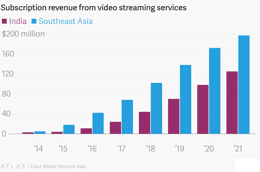Netflix faces rivals in India and Southeast Asia that are better adapted to local realities

Photo caption: Streaming live cricket, no doubt. (Reuters/Shailesh Andrade)
By Josh Horwitz
Special to The Post
When Netflix launched in 130 new countries in January, millions of households worldwide finally got the chance to watch House of Cards on their computers and TV sets. But what about the Filipino hairdresser who wants to watch Imortal (a local drama) on her phone on break?
Startups throughout less affluent countries in Asia are launching low-cost alternatives to Netflix to serve the billions of consumers who either can’t afford it or wouldn’t want it. Backed by local funders, they’re hoping they can differentiate through not just lower subscription rates, but also a wider variety of local content, easier payment methods, and streaming technology better suited to the region’s often pokey internet speeds.
There are 35 video streamers across India and Southeast Asia offering subscription-based video-on-demand services, says Vivek Couto, founder of research firm Media Partners Asia.
In India, Eros, owned by a decades-old film studio, charges 80 cents for its most basic subscription. Other players include MyPlex, ZengaTV, Spuul, and Hotstar. The latter offers live streaming of cricket matches (the sport is hugely popular in India).
Hooq and iFlix lead regionally in Southeast Asia. Both launched in mid-2015 and offer a 50-50 mix of local and Hollywood content. They charge $2 to $3 per month, compared to Netflix’s fee of $7 to $10.
“We work with [local broadcaster] GMA in the Philippines, and that’s heavily watched on the service—even though people can turn on the TV and watch the same thing,” says Michael Smith, chief technology officer at Hooq. “The local stuff is going to have a lot of play.”
The market for subscription-based video streaming in Southeast Asia is set to generate almost $42 million from subscriptions this year, and more than four times that by 2021, according to Media Partners Asia. That marks an average annual growth rate of 80%—roughly on a par with India. But in India, price competition from more players will likely make the country less lucrative.
Southeast Asia poses many challenges for streaming video companies.Credit card penetration rates are low, so Netflix isn’t even an option for many of the region’s consumers. Hooq and iFlix work with local telcos to allow carrier billing (Hooq is partially owned by Singtel, owner of the largest mobile operator in Singapore).
In addition, internet speeds can be cripplingly slow. Many consumers watch video on low-cost Android phones with prepaid plans. Hooq and iFlix have to ensure picture quality remains solid on poor bandwidth and cheap devices.
“People in Southeast Asia aren’t running around with 10 gigabytes a month to burn” says Smith. “If you’re buying your SIM card and it only has one gigabyte of data, a movie is still a couple hundred megs. So you could essentially watch two or three movies and… blow through a bandwidth cap that’s supposed to last all month.” The company added a feature to let subscribers watch videos offline while out and about.
When Silicon Valley giants expand abroad, local competitors often wonder if they’ll be be able to survive the competition. But iFlix chairman Patrick Grove argues that, unlike Uber and Amazon, the competitive dynamics of video streaming won’t create a single winner.
“If you are in the upper social class of our markets, you’ll have Netflix, HBO, or Hulu. But that’s just the top five percent [of the population] in these countries,” he said at the Tech in Asia 2016 conference in Singapore. “Everyone else in these markets doesn’t speak English and is using a prepaid phone.”
His company reached a million subscribers last December.
This piece was originally appeared in Quartz (qz.com). See http://qz.com/662620/netflix-faces-rivals-in-india-and-southeast-asia-that-are-better-adapted-to-local-realities/









